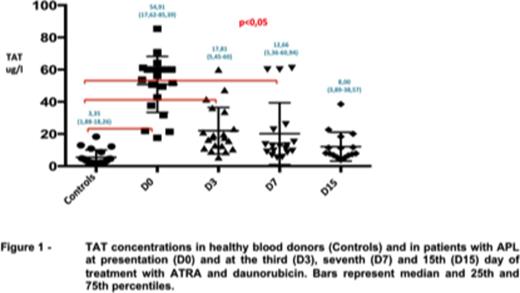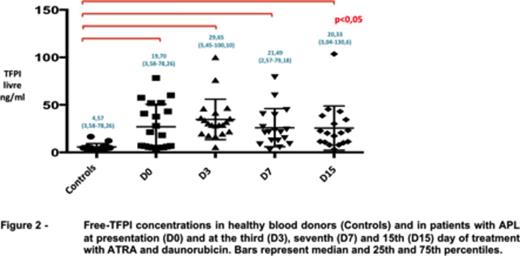Abstract
The characteristic coagulopathy in Acute Promyelocytic Leukemia (APL) is unique among the leukemias and thrombotic and bleeding complications remain the major causes of early deaths. APL promyelocytes express tissue factor (TF) which, after activation by phospholipids, forms a complex with factor VII and converts factor X to activated factor X. TF plays a central role in the pathogenesis of APL coagulopathy, for the procoagulant activity of lysates from freshly isolated APL cells is mainly attributed to TF. During periods of increased apoptosis of promyelocytes, the procoagulant activity is correspondingly intensified. In addition, APL cells may also induce TF procoagulant activity of endothelial cells through their secretion of IL-1b. The activity of the complex FVIIa-TF can be inhibited by the tissue factor pathway inhibitor (TFPI), but its role in the APL-associated coagulopathy remains unknown. This study aimed to determine the time-course of TFPI levels in patients with APL at diagnosis and during the first two-weeks of treatment with ATRA and anthracyclines. Twenty patients with de novo APL (12 males, age ranging from 17 to 72 years) and 20 healthy blood donors (age and sex matched) were included in this study. Peripheral blood (PB) samples were collected at diagnosis, and at D3, D7 and D15 of the induction therapy with ATRA and daunorubicin. The following plasma concentrations were determined: Thrombin-Antithrombin complex (TAT) (Enzygnost¨ TAT micro, Dade Behring/Siemens, IL, EUA), total TFPI (Asserachrom¨ total TFPI, Diagnostica Stago, Frana) and free TFPI (Asserachrom¨ free TFPI, Diagnostica Stago, Frana). The plasma concentrations of TAT were significantly higher in APL patients at presentation, D3 and D7 compared to controls, suggesting that the pathologic activation of coagulation was reversed by D15 of treatment Figure 1). The concentrations of free-TFPI were significantly higher in APL samples compared to controls in all time-points (Figure 2). In contrast, the concentrations of the truncated form of TFPI (estimated by subtracting the free-TFPI values from total-TFPI concentration) did not vary significantly between the groups. Since, free-TFPI (intact form) has been proven to present higher capacity to inhibit the activated factor X and VIIa-TF proteases than truncated-TFPI (bound to lipoprotein), we hypothesized that our findings confirm the relevance of free-TFPI in APL coagulopathy. To test whether the administration of rh-TFPI may revert aberrant activation of coagulation in APL patients, we developed a murine model using the IV infusion of NB4 cells. Similarly to the reported in APL patients, we observed an increase on TAT levels in mice injected with 5x106 NB4 cells [(60.7 ng/ml (24 - 116 ng/ml) vs 11.5 ng/ml (2.2 - 27.8 ng/ml), p<0.05)]. In contrast, murine TFPI levels decreased 30 minutes after the infusion of NB4 cells [30 ng/ml (5.8 - 217 ng/ml) vs 202 ng/ml (46 - 354 ng/ml)], suggesting that it was rapidly consumed. Unfortunately, it was not possible to distinguish between truncated and intact TFPI forms in mice. Intravenous infusion of recombinant human (rh) TFPI at the dose of 10mg/Kg significantly decreased the TAT levels (Figure 3) and increased TFPI levels in the murine model. In conclusion, our data on clinical samples and pre-clinical data using a murine model suggest that treatment with rh-TFPI may be a strategy to counteract APL-associated coagulopathy.
No relevant conflicts of interest to declare.
Author notes
Asterisk with author names denotes non-ASH members.




This feature is available to Subscribers Only
Sign In or Create an Account Close Modal